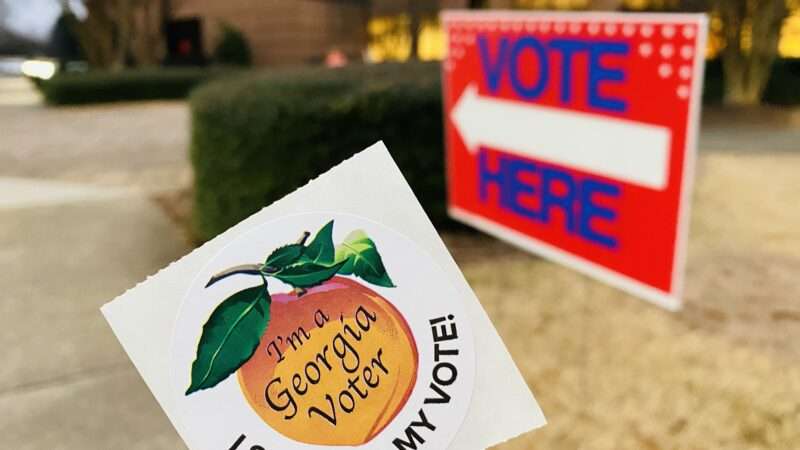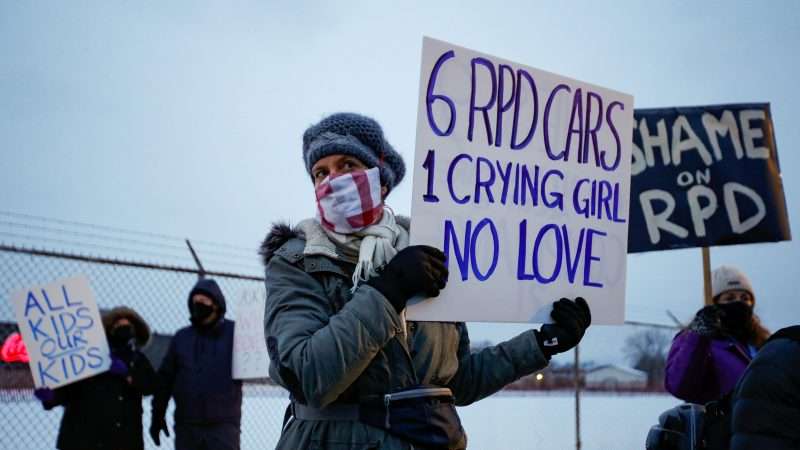
Republicans rush through a ream of voting restrictions in Georgia. A new law that Georgia’s GOP is peddling as an “election integrity” measure contains a host of problematic provisions, including a ban on handing out water or food to people waiting in line to vote and a ban on taking pictures of completed ballots (even your own).
Under the new law, “it shall be illegal for any person to…photograph or record a voted ballot.” Anyone who does so will be guilty of a misdemeanor crime.
An exception is made for the Georgia secretary of state, who will actually be required to digitize and publicize images of paper ballots. The new law creates “a pilot program for the posting of digital images of the scanned paper ballots created by the voting system.” These scanned images “shall be public records subject to disclosure.”
Those are just two of many questionable new rules for Georgia contained in the bill’s 96 pages. Another provision stipulates that no person shall “give, offer to give, or participate in the giving of any money or gifts, including, but not limited to, food and drink” to anyone within a polling place, within 150 feet of a building where voting takes place, or “within 25 feet of any voter standing in line to vote at any polling place.” (Self-service water stations are OK.)
Republicans are calling it the Election Integrity Act of 2021.
Opponents, meanwhile, have dubbed it the Voter Suppression Bill, owing to the range of new restrictions on voting that it lays out. The New Georgia Project, the Black Voters Matter Fund, and Rise Inc. have already filed a lawsuit against it.
Imagine making it a crime to offer water to people waiting in line to vote.
— Justin Amash (@justinamash) March 26, 2021
Gov. Brian Kemp and other state Republicans say the new law is necessary to stop voter fraud. But to anyone whose brain hasn’t been melted by partisan politics, it’s a pretty transparent attempt to sway election results, or at least to play to voter fraud fears. Georgia—which President Joe Biden won in 2020—was the site of extensive Trump team bellyaching, investigation, and legal maneuvering, and yet attempts to uncover the fabled widespread voter fraud never panned out.
“The bill passed both chambers of the legislature in the span of a few hours before Republican Gov. Brian Kemp signed it Thursday evening,” notes CNN.
State Rep. Park Cannon (D–Atlanta), a lawmaker who knocked on Kemp’s door during the signing of the bill, was arrested and escorted out of the building by state police.
“Cannon was charged with willful obstruction of law enforcement officers by use of threats or violence and preventing or disrupting general assembly sessions,” reports NPR. “The Georgia State Constitution states that lawmakers ‘shall be free from arrest during sessions of the General Assembly’ except for treason, felony, or breach of the peace.”
Here’s more video from @TWareStevens, showing Rep. Cannon knocking on the door to the Governor’s office.
“I’mma tell you one more time to step back,” the officer says. #gapol
Full video: https://t.co/2lUgKOxbZt pic.twitter.com/HKuKsBgg6n
— stephen fowler (@stphnfwlr) March 25, 2021
Some of the most controversial earlier elements of the bill—restricting weekend voting hours, requiring an excuse to vote absentee—were nixed before passage. And not all of the measures contained in the massive new bill are controversial.
“Many of the measures in SB 202 will streamline the election administration process at the local level, such as allowing officials to process absentee ballots sooner, require them to count ballots nonstop once the polls close and allow flexibility with voting equipment for smaller, lower-turnout races,” NPR points out. “Poll workers could serve in neighboring counties, after the pandemic saw a shortage of trained workers.” And “precincts with more than 2,000 voters that have lines longer than an hour at three different points throughout the day have to add more machines, add more staff or split up the poll”
But mixed in with these are provisions that seem designed to restrict voting access, complicate the process, or make it easier for state officials to intervene. Some of these include:
- Increasing voter ID requirements for people mailing in absentee ballots, who now have to submit identification details and a driver’s license number or other forms of government-issued ID when requesting an absentee ballot as well as when submitting it. A vote may be rejected if any ID details don’t match up between the request and the submission.
- Cutting down on the number of absentee ballot boxes that can be used.
- Limiting mobile voting stations to emergency use.
- Requiring that absentee ballots be requested at least 11 days before the election (previously, they could be requested through the Friday before Election Day).
- Requiring counties to publish the total number of votes cast and by what methods by 10 p.m. on election night.
- Allowing the State Election Board to “suspend county or municipal superintendents and appoint an individual to serve as the temporary superintendent in a jurisdiction.”
- Allowing a Georgia voter to challenge the qualifications of an unlimited number of other voters in their county or municipality.
You can read the full thing here.
FREE MINDS
Parler pushes back on claims of indulging Capitol rioters. Parler has been blamed for allegedly allowing “extremist” content in the lead-up to the January 6 Capitol riot. But the social network says it referred content to the FBI more than 50 times in the weeks leading up to the riot. From The Wall Street Journal:
Parler in December began alerting the bureau to content suggesting the possibility of violence at the Capitol as Congress met to confirm President Biden’s victory, the company wrote in a letter to the House Oversight and Reform Committee, which is investigating Parler and its role in the siege.
The social-media site referred a number of posts to law enforcement, including one on Dec. 24 from a user who called for an “armed force” of 150,000 people to “react to the congressional events of January 6,” according to the letter, which included the post and communications with FBI officials among its exhibits and has been reviewed by The Wall Street Journal.
Parler said it forwarded to the Federal Bureau of Investigation on Jan. 2 a series of posts from a user saying he would be wearing body armor to the pro-Trump rally on Jan. 6. “It’s no longer a protest,” Parler quoted the post as saying. “This is a final stand where we are drawing the red line at Capitol Hill. I trust the American people will take back the USA with force and many are ready to die to take back #USA.”
FREE MARKETS
New York is finally close to easing rules on recreational marijuana. Reason‘s Scott Shackford reports:
At a press conference Wednesday, Gov. Andrew Cuomo announced that an agreement was close and that lawmakers were reviewing the final details. The bill may be ready to be voted on as early as next week. The text of the bill is not yet public, but some of the details have been making its way out to New York media outlets….
Cuomo had been circulating his own legalization proposal that would completely forbid New Yorkers from growing their own—even for medical purposes. The draft now circulating would let New Yorkers grow their own weed: six plants at a time for their own use, but only three of which could be matured. Households with more than one adult could grow a maximum of 12 plants. Municipalities would be barred from banning people from growing their own, but they could establish restrictions.
If that part of the bill stays intact, it will be improvement over New Jersey’s recent legalization. New Jersey does not permit its citizens to grow their own marijuana. They have to purchase it from licensed dealers—who then, of course, have to direct a cut to the state via taxes.
New York’s bill will reportedly let cities opt out of allowing retailers, but it will also allow citizens to overrule such bans via ballot initiatives. The law would also permit social consumption sites, cafés where you can enjoy a little weed if you’re, say, a parent frustrated at the absurd corruption of your state’s government and in need of a little relaxation but don’t want marijuana in your house with the kids.
Licensed retail shops aren’t scheduled to begin opening under the current proposal until December 2022. Marijuana products will be taxed at 9 percent, and then an additional 4 percent tax will apply.
QUICK HITS
• A dispatch from the latest Big Tech hearing before Congress, which occurred yesterday in the House Energy and Commerce Committee and was ostensibly concerned with the spread of misinformation online.
Congress is so certain that tech companies are doing everything wrong, and for bad reasons, that it's become blind to any actual truth, and thus incapable of doing anything that could actually help make things better.
It's the "la-la-la I can't hear you" approach to legislating.
— Cathy Gellis (@CathyGellis) March 25, 2021
• The White House is defending firing staff who admitted to ever using marijuana.
• In 28 states, there’s no minimum age for arresting kids. That needs to change, writes Reason‘s C.J. Ciaramella.
from Latest – Reason.com https://ift.tt/2P1vgCx
via IFTTT


